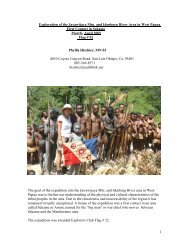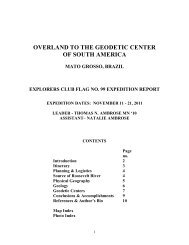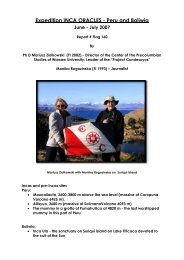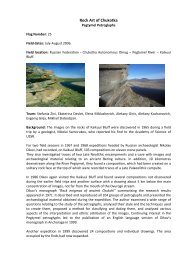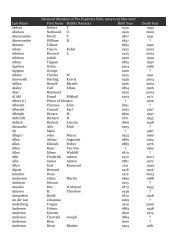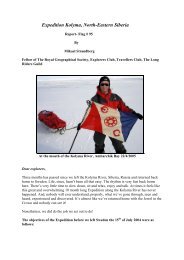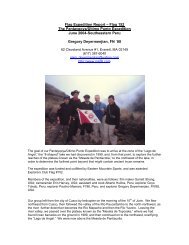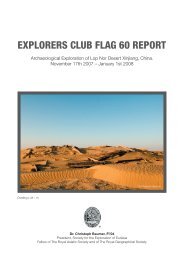the explorers journal the climate change issue - The Explorers Club
the explorers journal the climate change issue - The Explorers Club
the explorers journal the climate change issue - The Explorers Club
Create successful ePaper yourself
Turn your PDF publications into a flip-book with our unique Google optimized e-Paper software.
MICROBES ON THE ROCKS<br />
Germs frozen in glaciers for millions of years<br />
might revive as global warming melts <strong>the</strong> icecaps.<br />
Scientists investigated samples of <strong>the</strong> oldest known<br />
ice on Earth, which lies frozen in <strong>the</strong> Dry Valleys of<br />
<strong>the</strong> Transantarctic Mountains. After melting five<br />
ice blocks 100,000 to 8 million years old, Rutgers<br />
University marine microbiologist Kay D. Bidle<br />
and his colleagues found microbes in all <strong>the</strong> ice and<br />
grew <strong>the</strong>m in <strong>the</strong> lab, <strong>the</strong> first time scientists have<br />
ever resurrected such ancient, frozen life.<br />
While <strong>the</strong> young microbes grew very quickly,<br />
doubling in number every couple of days, <strong>the</strong><br />
older samples grew very slowly, doubling only<br />
every 70 days. Genetic analysis revealed <strong>the</strong> older<br />
DNA had deteriorated significantly, likely due to<br />
cosmic rays destroying it over time.<br />
While more ancient germs might not last<br />
past especially long deep freezes, <strong>the</strong>ir DNA still<br />
could. <strong>The</strong> researchers —whose findings are described<br />
online in <strong>the</strong> Proceedings of <strong>the</strong> National<br />
Academy of Sciences—suggest that as global<br />
warming melts <strong>the</strong> ice, prehistoric microbes or<br />
genes could flow into <strong>the</strong> seas, altering <strong>the</strong> evolution<br />
of microbes in <strong>the</strong> oceans.<br />
—CHARLES Q. CHOI<br />
30<br />
activity. This alarming trend is a critical finding that<br />
is now reshaping politics and becoming a factor in<br />
both our health and our economy. Without intervention,<br />
it will increasingly determine our overall<br />
quality of life. However, it is important to remember<br />
that we have options.<br />
While <strong>the</strong>re is no quick fix for our environmental dilemma,<br />
<strong>the</strong>re clearly needs to be action. Immediate<br />
reduction in <strong>the</strong> emissions of greenhouse gases<br />
such as CO 2<br />
and CH 4<br />
will reduce <strong>the</strong> time it takes<br />
<strong>the</strong> planet to recover, <strong>the</strong> severity of future <strong>change</strong>,<br />
and <strong>the</strong> probability of <strong>climate</strong> surprises. Immediate<br />
and more stringent reductions in <strong>the</strong> emissions of<br />
toxic metals and acid rain, for example, will yield<br />
a cleaner and healthier environment in months to<br />
years depending upon <strong>the</strong> degree of restriction.<br />
While it is certainly true that legislation will lay a major<br />
foundation for a cleaner, healthier environment,<br />
it will also depend to a large degree on <strong>the</strong> actions<br />
of those in <strong>the</strong> private and public sectors.<br />
Our future could be one characterized by energy<br />
efficiency and a return to more natural states of <strong>the</strong><br />
atmosphere. We have <strong>the</strong> ice cores to set our standards.<br />
<strong>The</strong> decision is ours and <strong>the</strong> opportunities<br />
for creativity in technology and lifestyle could drive<br />
us toward an amazing future.<br />
Acknowledgments<br />
U.S. research in <strong>the</strong> Arctic and Antarctica is supported by <strong>the</strong><br />
Office of Polar Programs of <strong>the</strong> National Science Foundation.<br />
Our research has been made possible through <strong>the</strong> combined<br />
efforts of national agencies such as <strong>the</strong> National Science<br />
Foundation; logistics support provided by <strong>the</strong> U.S. Navy<br />
and U.S. Air National Guard; help from contractors such as<br />
Ray<strong>the</strong>on Polar Services and VECO; <strong>the</strong> Scientific Committee<br />
for Antarctic Research (SCAR); and <strong>the</strong> efforts of <strong>the</strong> international<br />
scientific community.<br />
biography<br />
A Fellow of <strong>The</strong> <strong>Explorers</strong> <strong>Club</strong> and director of <strong>the</strong> Climate<br />
Change Institute at <strong>the</strong> University of Maine, Paul Andrew<br />
Mayewski has led more than 45 expeditions to <strong>the</strong> Arctic,<br />
Antarctic, Himalayas, and <strong>the</strong> Andes. Co-author of <strong>The</strong><br />
Ice Chronicles, Mayewski received <strong>the</strong> first SCAR Medal<br />
for Excellence in Antarctic Research in 2006. In October,<br />
Mayewski and colleagues will carry <strong>the</strong> <strong>Explorers</strong> <strong>Club</strong> Flag<br />
as <strong>the</strong>y undertake an over-snow traverse to <strong>the</strong> South Pole to<br />
collect ice cores and pursue related glaciological research.<br />
Dramatic human impact on <strong>the</strong> chemistry of <strong>the</strong> atmosphere over <strong>the</strong> past few decades compared to <strong>the</strong> last 5000 years as<br />
inferred from ice core records. Data for this figure from: Petit et al., 1999, Nature; Indermuhle et al., 1999, Nature; E<strong>the</strong>ridge<br />
et al., 1996, Journal of Geophysical Research; Blunier et al., 1995, Nature; E<strong>the</strong>ridge et al., 1998, Journal of Geophysical Research;<br />
Chappallez et al., 1999, Nature; Leuenberger and Sigenthaler, 1994, Trends; E<strong>the</strong>ridhe et al., 1994, Trends; Kang et<br />
al., 2002, Atmospheric Research; Mayewski et al., 1986, Science; 1990, Nature; Hong et al., 1994, 1996, Science; Schuster et al.,<br />
2002, Environmental Science and Technology.



